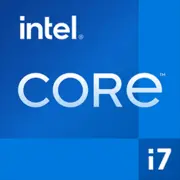Intel Core i7-12700T

Intel Core i7-12700T: Hybrid Power for Energy-Efficient Systems
March 2025
Introduction
The Intel 12th generation processors (Alder Lake) have been revolutionary due to their hybrid architecture, combining performance and efficiency cores. The Intel Core i7-12700T is one of the most interesting representatives of this lineup, featuring 12 cores, a TDP of 35W, and DDR5 support. In 2025, this chip remains relevant for compact PCs, office systems, and workstations. Let's explore who the i7-12700T is suitable for and how to use it effectively.
1. Key Specifications: Alder Lake Architecture and Key Features
Hybrid Architecture and Process Technology
The processor is built on Alder Lake's hybrid architecture, where 8 Performance-cores (P-cores) handle heavy tasks and 4 Efficient-cores (E-cores) manage background processes. P-cores operate with Hyper-Threading (16 threads), while E-cores do so without (4 threads), totaling 12 cores and 20 threads.
The Intel 7 process technology (10nm Enhanced SuperFin) provides a balance between energy efficiency and performance. The base frequency of the P-cores is 1.4 GHz, but in turbo mode, it reaches up to 4.6 GHz. This is ideal for systems with passive or compact cooling.
Cache and Graphics: A 25 MB L3 cache accelerates multithreaded tasks, while Intel UHD Graphics 770 (base clock 300 MHz, dynamic clock 1.5 GHz) handles 4K video and less demanding games.
Performance
- Geekbench 6: 2254 (single-core), 9882 (multi-core).
- Cinebench R23: ~1800 (Single Core), ~17000 (Multi Core).
In comparison, for multithreaded tasks, the i7-12700T is close to the Ryzen 7 7700X but consumes half as much power.
2. Compatible Motherboards: LGA 1700 Socket and Chipsets
Socket and Chipsets
The processor uses the LGA 1700 socket, compatible with the following chipsets:
- H610: Budget option for office PCs. No overclocking, limited PCIe 4.0 support. Example: ASUS Prime H610M-E ($120).
- B660: Optimal choice. Supports DDR4/DDR5, PCIe 4.0. Example: MSI PRO B660M-A WiFi ($150).
- Z690/Z790: For enthusiasts. Memory overclocking, more ports. Example: Gigabyte Z790 UD AC ($220).
Selection Features:
- A top-end chipset is not necessary for the i7-12700T; even the H610 will work due to its low TDP.
- If DDR5 is needed, choose boards with XMP 3.0 support.
3. Supported Memory: DDR4 vs DDR5
The processor works with DDR4-3200 and DDR5-4800. In 2025, DDR5 has become more accessible, but DDR4 is still advantageous:
- DDR4-3200 32GB: $80–100.
- DDR5-4800 32GB: $130–160.
Recommendations:
- For office tasks and media centers — DDR4.
- For workstations (rendering, encoding) — DDR5 with low timings.
4. Power Supply: Calculating Power
With a TDP of 35W, the processor has a modest impact on power consumption, but the overall system requires:
- Without discrete graphics: PSU 300–400W (e.g., be quiet! Pure Power 11 400W, $60).
- With a graphics card (NVIDIA RTX 4060 or similar): PSU 550–650W (Corsair RM650x, $100).
Important: Even high-wattage PSUs should not be low-quality — a risk to system stability.
5. Pros and Cons of Intel Core i7-12700T
Pros:
- Energy efficiency: Ideal for mini-PCs and systems with passive cooling.
- Multithreading: 20 threads handle rendering and virtualization well.
- Integrated graphics: Runs CS:GO at 60 FPS (1080p, low settings).
Cons:
- Low base frequency: In heavy tasks without turbo boost, lags may occur.
- No overclocking: The non-K version does not support overclocking.
- Price: In 2025, the chip costs $320–350, which is more expensive than the Ryzen 7 7700 ($300).
6. Use Cases
Office and Multimedia
- Example: Build based on ASUS Prime H610M-E, 16GB DDR4, 1TB SSD. Power consumption — 50W at idle, noise — 22 dB. Suitable for document work and 4K video.
Gaming
- Example: With RTX 4060 and DDR5-4800, the processor delivers 100+ FPS in Fortnite (1080p, Epic). However, in CPU-intensive games (Cyberpunk 2077), there may be drops due to the base frequency.
Work Tasks
- Virtualization (VMware), 3D rendering (Blender), video encoding (HandBrake) — thanks to the 20 threads.
7. Comparison with Competitors
AMD Ryzen 7 7700
- Pros of AMD: Higher IPC, PCIe 5.0 support, price $300.
- Cons: 8 cores versus 12, TDP 65W.
Conclusion: For gaming, the Ryzen 7 7700 is better; for multithreading tasks, the i7-12700T excels.
Apple M2 (in mini-PC)
- Pros of Apple: Energy efficiency, integration with macOS.
- Cons: Limited software compatibility, price starting at $600.
8. Building Tips
1. Cooling: Even the stock cooler is sufficient, but for quiet operation, consider the Noctua NH-L9i ($50).
2. Case: Mini-ITX (Cooler Master NR200) or compact Micro-ATX.
3. Drives: Ensure to use NVMe SSD (e.g., Samsung 980 Pro 1TB, $120).
9. Final Conclusion: Who Should Choose the i7-12700T?
This processor is worth choosing if:
- A quiet and energy-efficient system is needed (office, home server).
- Multithreaded performance is required for work tasks.
- There are plans to use it in a compact case.
Target Audience:
- IT specialists working with virtualization.
- Enthusiasts building media centers.
- Office employees who appreciate quiet.
In 2025, the Intel Core i7-12700T remains a solid choice for those who do not need maximum clock speeds but seek a balance between power and energy consumption.
Basic
CPU Specifications
Memory Specifications
GPU Specifications
Miscellaneous
Benchmarks
Compared to Other CPU
Share in social media
Or Link To Us
<a href="https://cputronic.com/en/cpu/intel-core-i7-12700t" target="_blank">Intel Core i7-12700T</a>